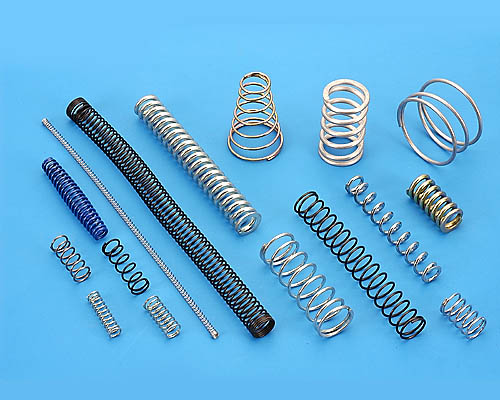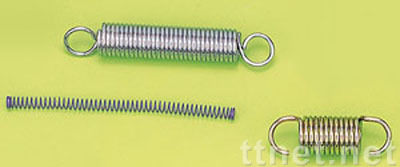拉簧
 拉簧
拉簧
拉簧
材質:各種金屬,不鏽鋼,高碳鋼,琴鋼線,磷銅線
 拉簧
拉簧
拉簧
拉簧是一種彈簧,當拉伸時會提供力量,通常用於吊掛和支撐物體的應用中。拉簧通常是直線狀的,由一個或多個圓形截面的線材製成。
拉簧可以在各種不同的產品中使用,例如手提箱、工具箱、門鎖、屏幕支架、燈具等。拉簧的尺寸和形狀可以根據不同的應用進行定制,以確保其滿足特定的需求。
拉簧的設計和製造需要考慮多種因素,例如彈簧常數、彈簧比例極限、材料選擇、彈簧直徑、彈簧長度等。製造拉簧需要使用高精度的機器和工具,以確保產品的尺寸和形狀精確,並且需要進行嚴格的品質控制和檢測,以確保產品的質量和性能符合標準要求。
總之,拉簧是一種常見的彈簧,具有吊掛和支撐物體的功能,廣泛應用於各種不同的產品中。在製造拉簧時需要考慮多種因素,以確保產品的質量和性能符合標準要求
拉簧是一種彈簧,常用於機械裝置、工具、玩具等產品中。它由彈性金屬材料製成,通常是鋼或合金。拉簧的主要功能是在受到壓縮或拉伸力時產生彈性回彈力,這種彈性力量可以用於許多不同的應用。
拉簧可以具有不同的形狀和結構,以滿足不同應用的需求。常見的拉簧類型包括壓縮彈簧、拉伸彈簧和扭轉彈簧。壓縮彈簧是最常見的類型,它們通常是圓柱形狀,當受到壓縮力時縮短,當壓力減小或消失時恢復原狀。
拉簧具有多種應用。例如,它們可以用於車輛懸掛系統中的避震器,使其能夠吸收和減緩道路上的顛簸。拉簧也用於機械鎖中,提供門鎖的回彈力,確保門在關閉時緊密密封。此外,拉簧還廣泛應用於玩具、家具、手工藝品、工業機械等領域。
總結來說,拉簧是一種彈性金屬製品,通常由鋼或合金製成,可以在受到壓縮或拉伸力時產生彈性回彈力。它們廣泛應用於各種機械裝置和產品中,具有重要的功能和作用。
除了上述提到的壓縮彈簧、拉伸彈簧和扭轉彈簧之外,還有其他一些特殊類型的拉簧,下面介紹一些常見的:
扭轉彈簧:扭轉彈簧是一種以螺旋形狀排列的彈簧,主要用於扭轉運動中的能量儲存和回彈作用。常見應用包括手動工具中的扳手、扭力扳手等。
波浪彈簧:波浪彈簧由連續排列的波浪形金屬帶組成,它們能夠提供更大的彈性變形和彈性力量。波浪彈簧常用於工業機械、車輛避震系統等需要承受大壓力和震動的應用。
絞線彈簧:絞線彈簧是一種由多股金屬絞線組成的彈簧,它們通常具有較高的柔軟性和彈性。絞線彈簧常用於玩具、家具、筆記本電腦等產品中,提供較輕的壓縮或拉伸力量。
懸掛彈簧:懸掛彈簧通常用於懸掛系統中,如汽車的懸吊系統。它們能夠吸收道路震動,提供平穩的駕駛體驗,同時保護車輛的結構和乘客的舒適性。
彈簧鎖環:彈簧鎖環是一種特殊的彈簧結構,常用於連接和固定零件。它們通常由彈性金屬環製成,可以在結構上提供一定的壓力和回彈力,以確保零件的安全固定。
這些是一些常見的拉簧類型,每種類型都有不同的特點和應用。根據具體的需求和應用場景,可以選擇合適的拉簧類型以滿足所需的彈性力量和運動要求。
材質:各種金屬,不鏽鋼,高碳鋼,琴鋼線,磷銅線
拉簧可以使用各種金屬材料製成,其中一些常見的材料包括不鏽鋼、高碳鋼、琴鋼線和磷銅線。這些材料具有不同的特性和適用範圍,可以根據具體的應用需求選擇適合的材料。
不鏽鋼:不鏽鋼具有優異的耐腐蝕性和耐熱性,能夠在惡劣環境中長時間使用而不生銹。這使得不鏽鋼成為許多需要抗腐蝕和耐用性的應用中的理想材料。不鏽鋼拉簧常用於食品加工、醫療設備、航空航天等領域。
高碳鋼:高碳鋼具有優異的彈性和強度,適用於需要較大彈性力量和回彈力的應用。高碳鋼拉簧常見於汽車懸吊系統、工業機械等需要承受高壓力和重載荷的場合。
琴鋼線:琴鋼線是一種高純度的鋼線,具有優異的彈性和音樂品質。它常用於製作樂器的弦,如鋼琴、吉他等。琴鋼線也可以在其他需要彈性和耐久性的應用中使用,例如高級機械設備。
磷銅線:磷銅線具有良好的電導性和彈性,常用於電子和電氣領域中。磷銅線拉簧常見於電子設備、開關、連接器等應用中,用於提供電子元件的接觸力和連接彈性。
這些材料在拉簧製造中都有各自的優勢和適用範圍。根據具體的應用需求,可以選擇適合的材料以確保拉簧在使用時具有所需的彈性性能和耐用性。
除了前面提到的不鏽鋼、高碳鋼、琴鋼線和磷銅線之外,還有其他一些常用的金屬材料可以用於製造拉簧,以下是其中幾種:
鋁合金:鋁合金具有較輕的重量和良好的抗腐蝕性,適用於需要較輕量化和抗腐蝕的應用。鋁合金拉簧常見於航空航天、運動器材等領域。
鈦合金:鈦合金具有優異的強度和耐腐蝕性,同時具有輕量化的特點。鈦合金拉簧常用於高溫環境、航空航天等對重量和耐腐蝕性有嚴格要求的應用。
鎳合金:鎳合金具有優異的耐腐蝕性、高溫強度和優異的彈性性能。鎳合金拉簧常見於化學工業、石油開采等腐蝕性和高溫環境中的應用。
銅合金:銅合金具有良好的導電性和熱傳導性,同時具有良好的彈性和耐磨性。銅合金拉簧常見於電子、電氣、汽車等應用中,用於導電接觸、彈簧接點等。
這些金屬材料在不同的應用領域中具有不同的特性和優勢。選擇適當的金屬材料取決於拉簧需要承受的負載、環境條件、耐腐蝕性要求等因素。製造拉簧時,材料的選擇對於最終產品的性能和可靠性至關重要。
拉簧,作為彈簧的一種特別形式,廣泛應用於各種機械設備和日常用品中。無論是工業機械中的關鍵部件,還是生活用品中的細小元件,拉簧都發揮著不可或缺的作用。本文將探討拉簧的基本原理、種類、製造工藝、應用範圍以及未來發展趨勢。
拉簧的基本原理
拉簧的工作原理基於胡克定律,即在彈性極限內,彈簧的伸長或壓縮量與所受的力成正比。拉簧通常用於承受拉力,兩端通常帶有鉤子或環,用於固定和連接不同的部件。當拉簧被拉伸時,它會儲存能量,並在外力解除後迅速恢復原狀,釋放儲存的能量。
拉簧的種類
根據用途和設計,拉簧可以分為多種類型:
圓柱形拉簧:最常見的拉簧類型,通常用於各類機械裝置和日常用品中。
錐形拉簧:一端直徑較小,逐漸變大,適用於需要變化彈力的場景。
雙鉤拉簧:兩端帶有鉤子,用於固定和連接特定部件。
異形拉簧:根據特定需求設計的特殊形狀拉簧,用於滿足不同機械設備的特殊需求。
拉簧的材料選擇
製作拉簧的材料主要包括高碳鋼、不銹鋼、合金鋼以及鎳合金等。這些材料具有高彈性、高強度和耐疲勞等優點,能夠在多次使用中保持穩定的性能。隨著材料科學的不斷發展,更多具有優異性能的新材料也被逐步應用於拉簧的製造中。
拉簧的製造工藝
拉簧的製造是一個複雜的過程,涉及多道工序和精密的控制。以下是拉簧生產的主要步驟:
原材料準備
拉簧的生產始於高品質原材料的選擇和預處理。根據拉簧的用途和要求,選擇合適的材料並進行清洗和去除雜質,以確保材料的純淨度和穩定性。
成形加工
成形是拉簧生產的關鍵步驟。根據拉簧的形狀和尺寸,成形方法包括冷加工和熱加工。冷加工主要用於製作小型和中型拉簧,而大型拉簧則通常採用熱加工工藝。
熱處理
熱處理是提升拉簧性能的重要工序。通過淬火、回火和退火等熱處理方法,可以改善拉簧的內部結構和力學性能,使其具有更高的硬度、彈性和抗疲勞性能。
表面處理
為了提高拉簧的抗腐蝕性能和美觀度,需要進行表面處理。常見的表面處理方法包括電鍍、噴漆和氧化等。這些處理不僅能夠延長拉簧的使用壽命,還可以提高其在惡劣環境下的穩定性。
質量檢測
每一個出廠的拉簧都需要經過嚴格的質量檢測。質量控制部門會對拉簧的尺寸、彈性和耐久性進行全面檢測,確保其符合設計要求和行業標準。
拉簧的應用範圍
拉簧在各類機械設備和日常用品中有著廣泛的應用,以下是幾個主要應用領域:
工業機械
在工業機械中,拉簧的應用非常廣泛。比如,各類機床、壓力機和自動化設備中,拉簧負責提供穩定的拉力和恢復力,保證機械裝置的正常運轉和精確控制。
汽車工業
在汽車工業中,拉簧廣泛應用於各類汽車零部件中,如離合器、剎車系統和車門鎖等。拉簧的存在確保了汽車的安全性和穩定性,提升了駕駛的舒適性和便捷性。
消費電子
在消費電子產品中,拉簧也發揮著重要作用。比如,各類遙控器、攝影機和手機中的按鍵和連接部件,拉簧提供了穩定的彈力和連接效果,確保產品的正常使用和耐久性。
醫療設備
在醫療設備中,拉簧同樣不可或缺。各類手術器械和醫療裝置中的拉簧,確保了操作的精確性和穩定性,提升了醫療設備的性能和可靠性。
日常生活用品
在日常生活中,我們經常能夠看到拉簧的身影。比如,彈簧床墊、自行車座椅和各類運動器材中,拉簧提供了舒適的彈性和支持,提升了使用體驗和舒適性。
拉簧的技術創新
隨著科技的不斷進步,拉簧的技術創新也在不斷推進。以下是幾個重要的技術創新方向:
自動化生產
自動化生產是現代拉簧製造的一大趨勢。自動化設備的引入,不僅提高了生產效率,還降低了人工成本和生產過程中的誤差。自動化成形機、數控機床和機器人技術的應用,使得拉簧生產變得更加精確和高效。
智能製造
智能製造是工業4.0時代的重要特徵。拉簧製造通過引入物聯網、人工智能和大數據技術,實現生產過程的智能化管理。這些技術可以實時監控生產狀態、預測設備故障和優化生產流程,從而提高生產效率和產品質量。
新材料的應用
新材料的開發和應用,是提升拉簧性能的重要途徑。比如,使用鎳鈦合金和複合材料,使得拉簧在重量、強度和耐腐蝕性方面有了顯著提升。這些新材料的應用,特別適用於高性能工業設備和惡劣環境下的應用。
綠色製造
環保和可持續發展是未來工業發展的重要方向。拉簧製造通過採用綠色製造技術,降低生產過程中的能耗和污染。比如,無鉛電鍍技術和節能型熱處理設備的應用,不僅減少了環境污染,還降低了生產成本。
拉簧技術的未來展望
隨著科技的不斷進步,拉簧技術的未來發展充滿了無限可能。以下是幾個重要的發展方向:
新型材料的研發
未來,隨著材料科學的進步,更多具有優異性能的新材料將被應用於拉簧的製造中。這些新材料將進一步提升拉簧的性能,滿足更加苛刻的應用需求。
更高精度的製造技術
隨著生產技術的進步,拉簧的製造精度將進一步提高。新型數控機床和先進的加工工藝,將使得拉簧的尺寸精度和性能穩定性達到新的高度。
智能化和數字化
智能化和數字化將成為未來拉簧製造的重要方向。通過引入人工智能和大數據分析,實現生產過程的全面自動化和智能化管理,將顯著提升生產效率和產品質量。
可持續發展
未來的拉簧製造將更加注重環保和可持續發展。通過採用綠色製造技術和可再生能源,減少生產過程中的能耗和污染,實現環保與經濟效益的雙贏。
結論
拉簧作為機械設備和日常用品中的重要元件,對確保設備的穩定性和可靠性起著關鍵作用。隨著科技的不斷進步,拉簧的製造技術和應用範圍也在不斷擴展。未來,隨著智能製造、綠色製造和新材料技術的發展,拉簧將迎來更加廣闊的發展空間,為現代工業和人類生活帶來更多的便利和可能。